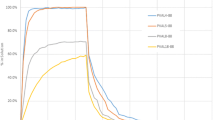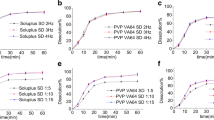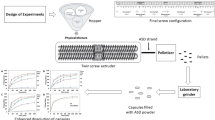Abstract
Purpose
The study aims to explore the potential of amorphous solid dispersion (ASD) technology in improving the solubility and bioavailability of flutamide (FLT), a poorly water-soluble drug. The introduction of beta-cyclodextrin (β-CD) is investigated as a strategy to overcome FLT’s solubility limitations.
Methods
The study employed various methods, including a validated UV spectrophotometric technique to assess FLT solubility and the creation of supersaturation through different β-CD and FLT combinations. Two formulation approaches, physical mixtures (PMs) and solid dispersions (SDs), were developed using freeze-drying and solvent evaporation methods. Analysis involved differential scanning calorimetry (DSC) and Fourier transform infrared spectroscopy (FTIR), along with loading and release tests, including statistical analysis of dissolution profiles.
Results
The FTIR analysis indicated that molecular interactions and chemical bonds remained largely unchanged. DSC results demonstrated the transformation of FLT from a crystalline to an amorphous state in the SDs. In the supersaturation test, it was evident that the solution with 30% β-CD and 70% FLT achieved a remarkable 5.69-fold increase in FLT concentration compared to the pure drug. Solid dispersion formulations exhibited varying drug release profiles, with the 30% β-CD and 70% FLT combination showing the most rapid release, reaching approximately 50% within 240 min.
Conclusion
The study underscores the effectiveness of β-CD in the 30:70 β-CD to FLT combination to enhance FLT solubility and bioavailability. However, higher proportions of β-CD led to reduced drug release, potentially due to cyclodextrin aggregation, which could hinder drug interactions.
Graphical Abstract







Similar content being viewed by others
Data Availability
The datasets generated during and/or analyzed during the current study are available from the corresponding author on reasonable request.
References
Tiwari G, et al. Drug delivery systems: an updated review. Int J Pharm Investig. 2012;2(1):2–11.
Kaur P, Khatik GL. Advancements in non-steroidal antiandrogens as potential therapeutic agents for the treatment of prostate cancer. Mini-Rev Med Chem. 2016;16(7):531–46.
Jyothi BJ, Sreelakshmi K. Design and evaluation of self-nanoemulsifying drug delivery system of Flutamide. J Young Pharm. 2011;3(1):4–8.
Elkhodairy KA, Hassan MA, Afifi SA. Formulation and optimization of orodispersible tablets of flutamide. Saudi Pharm J. 2014;22(1):53–61.
Newman A, Nagapudi K, Wenslow R. Amorphous solid dispersions: a robust platform to address bioavailability challenges. Ther Deliv. 2015;6(2):247–61.
Ashwathy P, Anto AT, Sudheesh MS. A mechanistic review on the dissolution phase behavior and supersaturation stabilization of amorphous solid dispersions. Drug Dev Ind Pharm. 2021;47(1):1–11.
Singh A, Van den Mooter G. Spray drying formulation of amorphous solid dispersions. Adv Drug Deliv Rev. 2016;100:27–50.
Solanki NG, Kathawala M, Serajuddin ATM. Effects of surfactants on itraconazole-hydroxypropyl methylcellulose acetate succinate solid dispersion prepared by hot melt extrusion III: tableting of extrudates and drug release from tablets. J Pharm Sci. 2019;108(12):3859–69.
Ravikumar AA, et al. Carvedilol precipitation inhibition by the incorporation of polymeric precipitation inhibitors using a stable amorphous solid dispersion approach: formulation, characterization, and in vitro in vivo evaluation. Polymers (Basel). 2022;14(22).
Chavan RB, Lodagekar A, Shastri NR. Determination of precipitation inhibitory potential of polymers from amorphous solid dispersions. Drug Dev Ind Pharm. 2018;44(12):1933–41.
Pandi P, et al. Amorphous solid dispersions: an update for preparation, characterization, mechanism on bioavailability, stability, regulatory considerations and marketed products. Int J Pharm. 2020;586:119560.
Munnangi SR, et al. Drug complexes: perspective from academic research and pharmaceutical market. Pharm Res. 2023;40(6):1519–40.
Liu M, et al. Supersaturation maintenance of carvedilol and chlorthalidone by cyclodextrin derivatives: pronounced crystallization inhibition ability of methylated cyclodextrin. Int J Pharm. 2023;637:122876.
Allahyari S, et al. Preparation and characterization of cyclodextrin nanosponges for bortezomib delivery. Expert Opin Drug Deliv. 2020;17(12):1807–16.
Palassi S, et al. Preparation and in vitro characterization of enoxaparin nano-liposomes through different methods. Adv Pharm Bull. 2021;11(2):295–300.
Brahman PK, et al. Voltammetric determination of anticancer drug flutamide in surfactant media at polymer film modified carbon paste electrode. Colloids Surf A: Physicochem Eng. 2012;396:8–15.
Mahmoudian M, Zakeri-Milani P, Valizadeh H. Investigating intestinal permeability of bortezomib using a validated HPLC-UV method. Drug Res (Stuttg). 2019;69(3):130–5.
Alsalhi MS, Royall PG, Chan KLA. Mechanistic study of the solubilization effect of basic amino acids on a poorly water-soluble drug. RSC Adv. 2022;12(30):19040–53.
Alwossabi AM, et al. Solubility enhancement of some poorly soluble drugs by solid dispersion using Ziziphus spina-christi gum polymer. Saudi Pharm J. 2022;30(6):711–25.
Dixit M, et al. A novel technique to enhancing the solubility and dissolution of flutamide using freeze drying. Turk J Pharm Sci. 2012;9:139–50.
Pacułt J, et al. How can we improve the physical stability of co-amorphous system containing flutamide and bicalutamide? The case of ternary amorphous solid dispersions. Eur J Pharm Sci. 2021;159:105697.
Sareen S, Mathew G, Joseph L. Improvement in solubility of poor water-soluble drugs by solid dispersion. Int J Pharm Investig. 2012;2(1):12–7.
Rawat S, Jain SK. Solubility enhancement of celecoxib using β-cyclodextrin inclusion complexes. Eur J Pharm Biopharm. 2004;57(2):263–7.
Arul Gnana Dhas AS, et al. Intramolecular charge transfer effects on flutamide drug. J Fluoresc. 2010;20:809–820.
Sid D, et al. Solubility enhancement of mefenamic acid by inclusion complex with β-cyclodextrin: in silico modelling, formulation, characterisation, and in vitro studies. J Enzyme Inhib Med Chem. 2021;36(1):605–17.
Allahyari S, et al. In-vitro characterization and cytotoxicity study of flutamide loaded cyclodextrin nanosponges. J Drug Deliv Sci Technol. 2021;61:102275.
Nagarjuna G, Babu PK, Maruthi Y, Parandhama A, Madhavi C, Subha MC, Chowdojirao K. Interpenetrating polymer network hydrogel membranes of karayagum and sodium alginate for control release of flutamide drug. 2016;6(12):011–019.
Hiew TN, Zemlyanov DY, Taylor LS. Balancing solid-state stability and dissolution performance of lumefantrine amorphous solid dispersions: the role of polymer choice and drug–polymer interactions. Mol Pharmaceutics. 2022;19(2):392–413.
Elgindy N, et al. Lyophilization monophase solution technique for improvement of the physicochemical properties of an anticancer drug, flutamide. Eur J Pharm Biopharm. 2010;74(2):397–405.
Homayouni A, et al. Preparation and characterization of celecoxib solid dispersions; comparison of poloxamer-188 and PVP-K30 as carriers. Iran J Basic Med Sci. 2014;17.
Sapkal S, et al. Solid dispersion of valsartan for solubility improvement using β-cyclodextrin. MOJ Bioequiv Availab. 2018;5:313–9.
Deshmane S. Behavioural study of cyclodextrin inclusion complex on enhancement of solubility of aceclofenac. Indian Drugs. 2015;52.
Qian F, Huang J, Hussain MA. Drug-polymer solubility and miscibility: Stability consideration and practical challenges in amorphous solid dispersion development. J Pharm Sci. 2010;99(7):2941–7.
Zhang D, et al. Processing impact on performance of solid dispersions. Pharmaceutics. 2018;10(3).
Huang Y, Dai WG. Fundamental aspects of solid dispersion technology for poorly soluble drugs. Acta Pharm Sin B. 2014;4(1):18–25.
Gala UH, et al. The effect of drug loading on the properties of abiraterone–hydroxypropyl beta cyclodextrin solid dispersions processed by solvent free KinetiSol® technology. Eur J Pharm Biopharm. 2021;165:52–65.
Saokham P, et al. Solubility of cyclodextrins and drug/cyclodextrin complexes. Molecules. 2018;23(5).
Jansook P, Ogawa N, Loftsson T. Cyclodextrins: structure, physicochemical properties and pharmaceutical applications. Int J Pharm. 2018;535(1):272–84.
Loftsson T, Saokham P, Couto AR. Self-association of cyclodextrins and cyclodextrin complexes in aqueous solutions. Int J Pharm. 2019;560:228–234.
Saokham P, et al. The self-assemble of natural cyclodextrins in aqueous solutions: application of miniature permeation studies for critical aggregation concentration (cac) determinations. Int J Pharm. 2016;505.
González-Gaitano G, et al. The aggregation of cyclodextrins as studied by photon correlation spectroscopy. J Incl Phenom Macrocycl Chem. 2002;44(1):101–5.
Shi N-Q, Yao J, Wang X-L. Effect of polymers and media type on extending the dissolution of amorphous pioglitazone and inhibiting the recrystallization from a supersaturated state. Drug Dev Ind Pharm. 2014;40(8):1112–22.
Dias MMR, et al. The effect of β-cyclodextrins on the permeation of diclofenac from supersaturated solutions. Int J Pharm. 2003;263(1):173–81.
Semalty M, et al. Cyclodextrin inclusion complex of racecadotril: effect of drug-β- cyclodextrin ratio and the method of complexation. Curr Drug Discov Technol. 2014;11(2):154–61.
Trivino A, et al. Drug–polymer miscibility, interactions, and precipitation inhibition studies for the development of amorphous solid dispersions for the poorly soluble anticancer drug flutamide. Drug Dev Ind Pharm. 2019;45(8):1277–91.
Swami G, et al. Preparation and characterization of domperidone-?-cyclodextrin complexes prepared by kneading method. Int J Adv Pharm Sci. 2010;1(1).
Yuvaraja K, Khanam J. Enhancement of carvedilol solubility by solid dispersion technique using cyclodextrins, water soluble polymers and hydroxyl acid. J Pharm Biomed Anal. 2014;96:10–20.
Rasheed A, Ashok Kumar CK, Sravanthi VVNSS. Cyclodextrins as drug carrier molecule: a review. Sci Pharm. 2008;76(4):567–598.
Acknowledgements
All figures presented in this study were generated using GraphPad Prism 9.5.1.
Funding
The authors would like to acknowledge the authorities of the Ardabil University of Medical Sciences for their financial support as a part of a registered proposal (IR.ARUMS.REC.1400.121).
Author information
Authors and Affiliations
Corresponding author
Ethics declarations
Ethics Approval
Not applicable.
Consent for Publication
All authors are happy with this publication.
Competing Interests
The authors declare no competing interests.
Additional information
Publisher's Note
Springer Nature remains neutral with regard to jurisdictional claims in published maps and institutional affiliations.
Rights and permissions
Springer Nature or its licensor (e.g. a society or other partner) holds exclusive rights to this article under a publishing agreement with the author(s) or other rightsholder(s); author self-archiving of the accepted manuscript version of this article is solely governed by the terms of such publishing agreement and applicable law.
About this article
Cite this article
Hoseini Aghdam, S., Allahyari, S. Enhancing the Dissolution of Flutamide Through Supersaturation Using Beta-Cyclodextrin: a Promising Approach for Improved Solubility of Poorly Water-Soluble Drugs. J Pharm Innov 18, 2294–2304 (2023). https://doi.org/10.1007/s12247-023-09793-8
Accepted:
Published:
Issue Date:
DOI: https://doi.org/10.1007/s12247-023-09793-8




